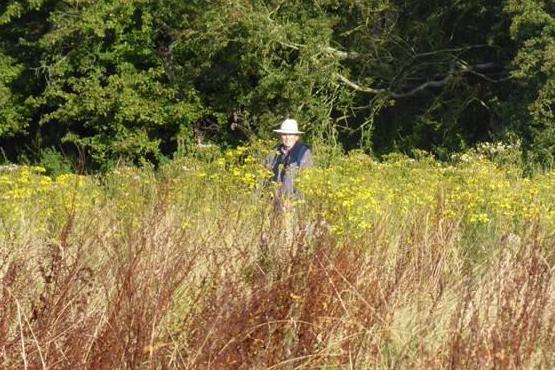Ragwort, Senecio jacobaea, is a prescribed injurious weed under the Weeds Act 1959, with special measures specified in the Ragwort Control Act 2003. Every part of the plant harbours toxic alkaloids which are poisonous to cattle when fresh, or dry (e.g., in hay or silage). On the other hand, Ragwort is the food plant of the striking yellow- and black-striped caterpillars of Cinnabar moths, Tyria jacobaeae, which are immune to the Ragwort toxins; and late summer Ragwort flowers are valuable pollen and nectar sources for other insects. Ragwort is a native British flower, and our Flora Preservation Trust has a duty to conserve representative populations. There are many Ragwort plants at Orchid Glade, while at Simpson’s Fromus Valley Reserve, there are scattered plants on most meadows, and one extensive patch on Meremeade (photograph).
Of all pastures in this reserve, Meremeade supports the least diverse grassland flora. A recommended practice to increase floristic diversity is to cut and remove the abundant growth of grasses, and conserve as hay or silage. The presence of this extensive patch of Ragwort eliminates the option to combine control with the conservation of winter feed for our cattle. Ragwort is a biennial, forming a leafy rosette on its first year and growing tall in its second year when it flowers and seeds. On 8th April (2022) a small Working Party assessed the current situation in the Fromus Valley.
The first image is of the shoulder-high grasses and Ragwort at Meremeade back in September 2021 (with Guardian Barry Cullen to give scale), whilst the others result from our survey this month.
 |
 |
|
| Meremeade, September 2021 (photo: Janey Cullen) | Close-up of leafy rosettes on the green pastures |
On the grazed pasture of Butcher’s (TM 3866 2757) we found a small patch of mixed large and small leafy rosettes. It was not difficult to spud or hoe these, and put them into a black bin-bag, for disposal.
A ‘spud’ is a long-handled tool with a small blade at the end, used to cut out thistles, ragwort etc. My father carried one on walks across our pastures, and had a special design made by the blacksmith.
 |
 |
|
| bagged-up Ragwort from the pastures | tall, dry Ragwort stalks on Meremeade |
The situation on Meremeade was altogether more difficult. There were plenty of tall, dry Ragwort stalks. With a firm pull, these came out of the ground with some root attached — all appearing totally dead. Serena searched the ground around some of these, and found clusters of small seedlings, sheltered by the surrounding tall grasses.
CONCLUSION
We concluded, first, that pulling the dead stems in Meremeade would not solve the problem in 2022; and, second, that the Ragwort seedlings in this field would be protected by the sheltering grasses from any attempt to apply herbicide. At present, there seems to be no solution, other than waiting for a month or so, and then returning to the task with another Working Party, and to spud out the plants of larger size that we expect, then, to find.
On the other pastures, at the same time, taller Ragwort plants will be showing, and it will be possible to spud or hoe these, and remove them.
